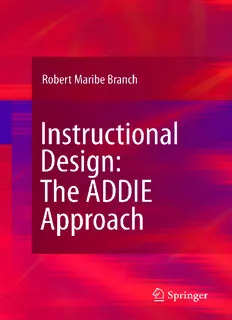Table Of Content
Instructional Design: The ADDIE Approach
Robert Maribe Branch
Instructional Design:
The ADDIE Approach
1 3
RobertMaribeBranch
DepartmentofEducationalPsychologyand
InstructionalTechnology
UniversityofGeorgia
604AderholdHall
Athens,GA30602
USA
[email protected]
ISBN978-0-387-09505-9 e-ISBN978-0-387-09506-6
DOI10.1007/978-0-387-09506-6
SpringerNewYorkDordrechtHeidelbergLondon
LibraryofCongressControlNumber:2009932903
#SpringerScienceþBusinessMedia,LLC2009
Allrightsreserved.Thisworkmaynotbetranslatedorcopiedinwholeorinpartwithoutthewritten
permissionofthepublisher(SpringerScienceþBusinessMedia,LLC,233SpringStreet,NewYork,
NY10013,USA),exceptforbriefexcerptsinconnectionwithreviewsorscholarlyanalysis.Usein
connectionwithanyformofinformationstorageandretrieval,electronicadaptation,computer
software,orbysimilarordissimilarmethodologynowknownorhereafterdevelopedisforbidden.
Theuseinthispublicationoftradenames,trademarks,servicemarks,andsimilarterms,evenifthey
arenotidentifiedassuch,isnottobetakenasanexpressionofopinionastowhetherornottheyare
subjecttoproprietaryrights.
Printedonacid-freepaper
SpringerispartofSpringerScience+BusinessMedia(www.springer.com)
Acknowledgments
I am grateful to my former colleagues in the Department of Instructional
Design, Development and Evaluation at Syracuse University and my current
colleaguesintheLearning,Design,andTechnologyprogramatTheUniversity
ofGeorgiaforbothallowingmetolearnhowtoteachinstructionaldesignand
encouraging me to share my use of ADDIE as an approach to instructional
design.
Iwanttoacknowledgethefollowingmembersofthetrainingdepartmentat
Universal Instruments in Binghamton, New York, during the early to mid-
1990swhohelpedshapesomeofmyinitialperceptionsaboutauthentictraining
development environments: Patricia Wrobel, Corporate Training Manager,
Gregory Taylor, Customer Training Manager, and trainers Steve Austin,
Charles Brown, Adolfo Lopez, and Edward Milot who comprised the ad hoc
InstructionalDesignGroup.
I look forward to the continued support of colleagues like Dr. Wendy
Thompson,anInstructionalDesignerattheCharlesDrewBiomedicalInstitute
inWashington,DC,andmycolleaguesfromatimebackattheUnitedStates
Bureau of the Census who provided opportunities for me to demonstrate the
effectiveness of the ADDIE approach to instructional design with national
implications.
I wish to thank Ted Lehne of the Learning Services Division at Delta Air
Lines, Susan Greathead, President of Lead America Corporation, and Lynn
Miller, Senior Enterprise Associate at the Center for Creative Leadership for
theirinspiration.
v
Contents
Prologue............................................... 1
Introduction ........................................... 2
LearningSpace ......................................... 5
PrinciplesofInstructionalDesign........................... 8
TheSystemsConcept .................................... 11
APartneringProcess..................................... 12
ADDIE:AnOverview.................................... 17
OrganizationoftheBook................................. 18
Summary.............................................. 20
1 Analyze ............................................... 23
IntroductiontoAnalyzePhase............................. 24
ValidatethePerformanceGap ............................. 25
SamplePerformanceDiscrepancies ....................... 25
SamplePerformanceAssessment ........................... 29
PurposeStatement..................................... 32
GuidelinesforComposingaPurposeStatement ............. 33
DetermineInstructionalGoals............................. 33
ConfirmtheIntendedAudience ............................ 37
GroupIdentifications .................................. 38
GeneralCharacteristics................................. 38
NumbersofStudents................................... 38
LocationofStudents................................... 39
ExperienceLevels ..................................... 39
Attitudes ............................................ 39
SkillsthatImpactPotentialtoSucceedintheLearning
Environment ......................................... 40
IdentifyRequiredResources............................... 43
ContentResources .................................... 43
TechnologyResources.................................. 43
InstructionalFacilities.................................. 43
HumanResources..................................... 44
vii
viii Contents
DeterminePotentialDeliverySystem........................ 47
Nine-StepEstimationProcedure.......................... 47
ComposeaProjectManagementPlan ....................... 52
Result:AnalysisSummary ................................ 56
2 Design ................................................ 59
IntroductiontoDesignPhase.............................. 60
ConductaTaskInventory ................................ 61
Assumptions ......................................... 62
PerformanceTask..................................... 63
Step1:RepeatthePurposeStatement ..................... 64
Step2:ReaffirmtheInstructionalGoals ................... 65
Step3:IdentifytheEssentialPerformanceTasks............. 65
GuidelinesforConstructingaTaskInventory............... 66
ComposePerformanceObjectives........................... 68
GenerateTestingStrategies................................ 71
PerformanceMatch.................................... 72
ConditionMatch...................................... 72
CriteriaMatch........................................ 72
CalculateReturnonInvestment............................ 73
WhatDotheFiguresMean?............................. 74
Cost/BenefitfortheSampleCase........................... 76
Example............................................. 79
Result:DesignBrief ..................................... 81
3 Develop ............................................... 83
IntroductiontoDevelopPhase............................. 84
GenerateContent ....................................... 85
InstructionalStrategies:Concept.......................... 85
InstructionalStrategies:Theory .......................... 85
BeginningActivities.................................... 86
MiddleActivities...................................... 86
EndingActivities...................................... 87
InstructionalStrategies:Practice.......................... 87
SelectorDevelopMedia.................................. 97
Media:Concept....................................... 98
Media:Theory........................................ 98
Auditory ............................................ 98
Visual............................................... 99
Kinesthetic........................................... 99
Media:Practice....................................... 100
DevelopGuidancefortheStudent .......................... 111
GuidancefortheStudent:Practice......................... 112
TitlePage............................................ 112
Contents ix
Copyright ........................................... 113
Acknowledgments..................................... 113
TableofContents ..................................... 113
Body ............................................... 113
Glossary............................................. 113
Appendix............................................ 113
Format.............................................. 114
ContentPresentation................................... 114
ExercisePresentation................................... 114
Sequence ............................................ 114
Quality.............................................. 115
Clarity .............................................. 115
Accuracy ............................................ 115
Consistency.......................................... 115
DevelopGuidancefortheTeacher.......................... 118
ConductFormativeRevisions.............................. 122
ConductaPilotTest..................................... 128
Result:LearningResources................................ 131
4 Implement ............................................. 133
IntroductiontoImplement................................ 133
PreparetheTeacher...................................... 134
PreparetheStudent...................................... 144
Result:AnImplementationStrategy ........................ 149
5 Evaluate............................................... 151
IntroductiontoEvaluate.................................. 152
DetermineEvaluationCriteria ............................. 152
Level1:Perception .................................... 154
Level2:Learning...................................... 156
Level3:Performance................................... 157
SelectEvaluationTools................................... 160
ConductEvaluations..................................... 161
Result:AnEvaluationPlan................................ 163
Epilogue............................................... 165
AppendixAFirefightersfortheDigitalAge:APracticeCase.......... 169
Introduction ........................................... 169
Context ............................................... 169
PrimaryCharacters(Thissectionshouldbecompleted
byyourdesignteam) ................................... 173
CaseEvents............................................ 173
x Contents
AppendixBSelf-TestofInstructionalDesignKnowledge ............. 175
ChoosetheBestAnswerforEachItem ...................... 175
AnswerKey............................................ 180
Glossary................................................... 183
Bibliography ............................................... 193
Books................................................. 193
BookChapters ......................................... 195
Article ................................................ 196
Internet ............................................... 198
Index..................................................... 199
Prologue
Contents
Introduction .......................................................... 2
LearningSpace ........................................................ 5
PrinciplesofInstructionalDesign.......................................... 8
TheSystemsConcept ................................................... 11
APartneringProcess.................................................... 12
ADDIE:AnOverview .................................................. 17
OrganizationoftheBook................................................ 18
Summary............................................................. 20
Abstract ADDIEisanacronymforAnalyze,Design,Develop,Implement,and
Evaluate.ADDIEisaproductdevelopmentparadigmandnotamodelperse.
The ADDIE concept is being applied here for intentional learning environ-
ments.TheapplicationofADDIEtoinstructionalsystemsdesignfacilitatesthe
complexities of intentional learning environments by responding to multiple
situations,interactionswithincontext,andinteractionsbetweencontexts.Yet,
the fundamental ADDIE components remain the same throughout various
applicationsandvariationsoftheADDIEparadigmdependonthecontextin
which ADDIE is being applied. Instructional design centers on individual
learning,hasimmediateandlong-rangephases,issystematic,andusesasystems
approachaboutknowledgeandhumanlearning.Effectiveinstructionaldesign
focuses on performing authentictasks, complex knowledge,and genuine pro-
blems. Thus, effective instructional design promotes high fidelity between
learning environments and actual work settings. However, instruction should
be considered asa potential intervention,only when a lackof knowledge and
skills has been validated as the main cause for a performance gap. Thus,
ADDIE can be applied when instruction is an appropriate response to a
performance discrepancy. Clients and other primary stakeholders should be
considered as people for whom you are providing a service. Subject matter
expertsandothercontentspecialistsshouldberegardedascooperatingpartners
of the design and development team. The simplicity of the ADDIE concept
combined with multiple prompts for inclusiveness continues to prove its
R.M.Branch,InstructionalDesign:TheADDIEApproach, 1
DOI10.1007/978-0-387-09506-6_1,(cid:2)SpringerScienceþBusinessMedia,LLC2009

